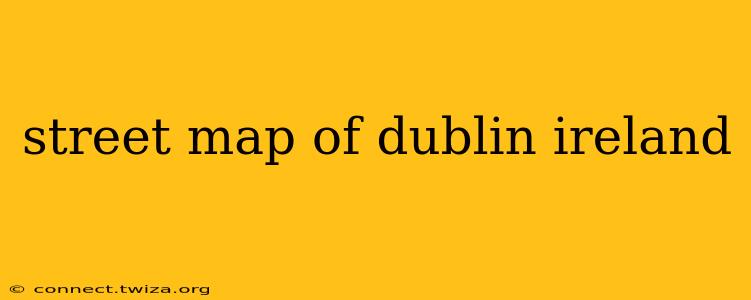Dublin, Ireland's vibrant capital, boasts a rich history woven into its very streets. Understanding its layout is key to unlocking the city's charm and experiencing its diverse offerings. This guide provides a comprehensive overview of Dublin's street map, helping you navigate its iconic thoroughfares and hidden gems.
What are the main streets in Dublin?
Dublin's street network, though seemingly chaotic at first glance, follows a largely organic pattern reflecting its historical development. Some key arteries define the city's character:
-
O'Connell Street: The widest street in Dublin, a grand thoroughfare running north-south, O'Connell Street is a focal point, lined with shops, hotels, and historical buildings. It's a bustling hub of activity, perfect for people-watching.
-
Grafton Street: Known for its high-end shopping and vibrant street performers, Grafton Street cuts through the heart of the city centre, connecting Trinity College to St. Stephen's Green. It's a pedestrianized paradise, ideal for a leisurely stroll.
-
Dame Street: A historic street that runs from College Green to the River Liffey, Dame Street houses many important government buildings and historical sites. Its proximity to Trinity College and Dublin Castle makes it a significant part of the city's heritage.
-
Henry Street: A major shopping street running parallel to O'Connell Street, Henry Street offers a wider range of retail options, often more budget-friendly than Grafton Street.
-
Baggot Street: Known for its many pubs, restaurants, and embassies, Baggot Street provides a glimpse into a more residential side of Dublin's city centre while still remaining easily accessible to major attractions.
What is the best way to explore Dublin's streets?
Exploring Dublin's streets offers a unique way to experience the city's soul. The best approach depends on your preference and the time you have available:
-
On Foot: Walking is the most rewarding way to truly appreciate the city's architecture, atmosphere, and hidden laneways. Many of the main streets are pedestrianized or easily walkable.
-
By Bus: Dublin Bus offers an extensive network covering the entire city. It's a cost-effective and convenient option for covering greater distances.
-
By Luas (Tram): The Luas tram system provides a modern and efficient way to travel between key areas, particularly the city centre and suburbs.
-
By Taxi or Ride-Sharing Service: Taxis and ride-sharing services are readily available for quicker transport, especially for longer distances or when carrying luggage.
-
By Bicycle: Dublin is becoming increasingly cycle-friendly, with dedicated cycle lanes and rental schemes available. Cycling offers a unique perspective on the city.
How can I find a specific address in Dublin?
Finding a specific address in Dublin is relatively straightforward, especially with the aid of online map services such as Google Maps or Apple Maps. These tools provide detailed street maps, satellite imagery, and directions. Entering the address into the search bar will pinpoint the location and provide walking, driving, or public transport directions.
Are there any pedestrianized areas in Dublin?
Yes, Dublin has several pedestrianized areas, primarily in the city centre. These areas are car-free zones, making walking particularly pleasant and safe. Grafton Street is a prime example, as are parts of Temple Bar and areas surrounding Trinity College.
What are some hidden gems to discover while exploring Dublin's streets?
Beyond the main streets, Dublin holds many hidden gems waiting to be discovered. Exploring the charming laneways and side streets will reveal unexpected architectural details, quirky shops, and cosy pubs. Consider venturing off the beaten path to uncover these hidden treasures. Many walking tours are available that specialize in this aspect.
This comprehensive guide offers a deeper understanding of Dublin's street map, encouraging exploration and appreciation of its unique urban fabric. By utilizing the various exploration methods and tools, visitors can easily navigate the city's rich tapestry of streets, uncovering its historical and cultural significance.
